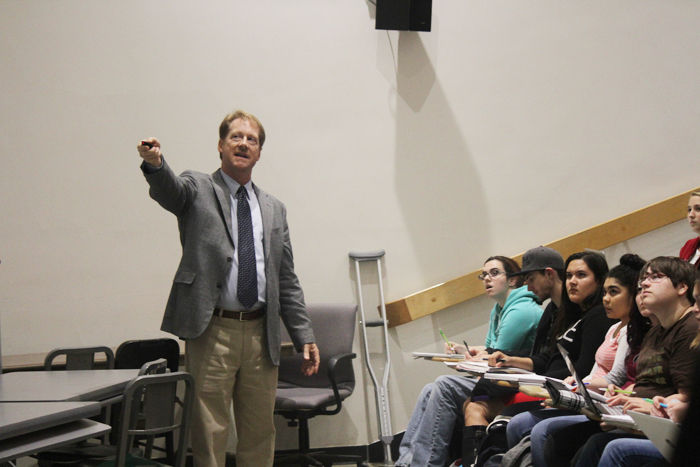Assisting zoo animals with healthier food plans
October 27, 2015
Humans aren’t the only species that needs to eat healthy, tortoises, horses, giant pandas and red pandas need to be concerned about it, too.
Mark Edwards from the California Polytechnic State University explained the importance of dietary management in certain species through his experiences and understanding of comparative nutrition Monday afternoon. His lecture was the College of Agricultural, Human, and Natural Resource Sciences’ (CAHNRS) annual John E. Halver Lecture.
Edwards got his start in animal nutrition while working with red pandas and learning about their high-fiber diet at the Smithsonian National Zoological Park in Washington D.C. The high-fiber diet was interesting, he said, because the red panda’s digestive system isn’t typical of an animal that intakes as much fiber as they do.
Unlike giant pandas, whose digestive systems are specialized to digest bamboo plant matter, the red panda’s is not specialized at all. As a result, they only extract one-fourth of the nutrients in bamboo.
Experience working with the diets of red pandas and additional digestive studies of red howler monkeys influenced Edwards to continue his education at Michigan State University, where his emphasis in comparative nutrition took root.
After finishing his graduate degree, Edwards began working at the San Diego Zoo where he oversaw the nutrition of all the different species hosted there.
“As a zoo nutritionist, your job is to not only provide the right nutrients for the animals but to know exactly how to provide those nutrients,” Edwards said.
Through collaborative efforts with the San Diego Zoo and the Chengdu Zoo in China, he worked to reform the feeding practices of giant pandas, among other projects.
“We worked to align the feeding and management of the panda to match its biological adaptations,” Edwards said. That work continued to be influenced and supported by his prior work with red pandas.
Edwards said that prior to his collaborative dietary regiments for pandas, zoos were feeding them a diet that was too high in protein and fat. It did not compare well with what pandas ate in the wild, which is predominantly bamboo.
The previous diet was shown to have a negative impact on the digestive health of the pandas because it was being provided through unnatural means. The supplementary research helped change that.
Research proved that it is best to put the supplemental nutrients such as protein and fat in a high-fiber matrix like bamboo because it is what pandas eat in the wild, and therefore does less damage to their adapted digestive system.
“Species adaptations and ecology should be considered in coming up with nutrition and feeding practices,” Edwards said.
Reporting by Dennis Farrell





















